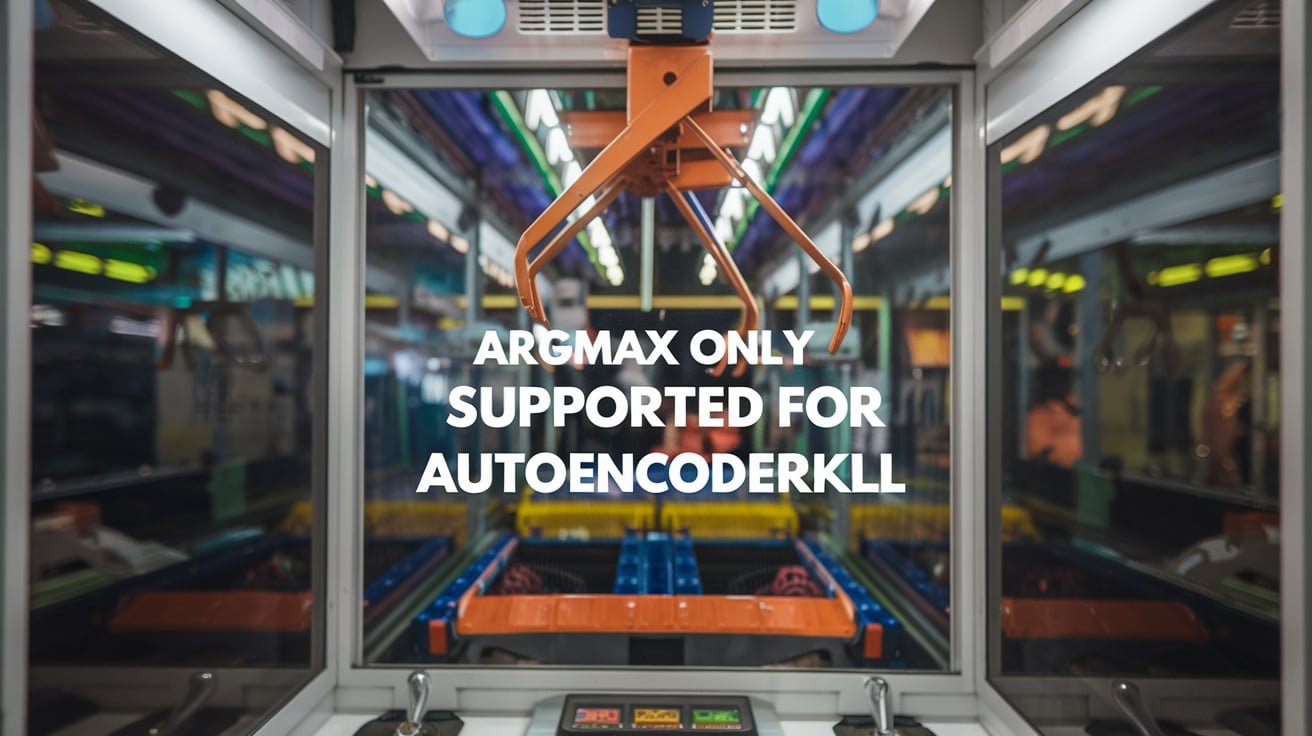Introduction argmax only supported for autoencoderkl
In the realm of machine learning and artificial intelligence, the terms “argmax“ and “autoencoderkl“ have specific, technical meanings that are often encountered in the context of neural networks and optimization algorithms. To understand why the error message “argmax only supported for autoencoderkl” appears and its significance, we first need to clarify the individual roles and functions of argmax and autoencoderkl in machine learning frameworks.
The argmax operation is a mathematical function often used in classification tasks. It is typically employed to return the index of the maximum value in a vector or an array. In simple terms, when you apply argma x to an array, it identifies the position of the highest value in the array, which is particularly useful in decision-making processes. For instance, you may have the vector of the output of a model of specific classes, and the objective here is to identify the class with the highest possibility. In that case, argmax is used to get a mark of the max value that will represent the predicted class.
Autoencoderkl is a particular type of neural network architecture that is most commonly used in unsupervised learning contexts. Self-supervised is a modification of the classical autoencoder where KL divergence is used, the latter being a technique to measure how much one probability distribution differs from a second expected distribution. The autoencoderkl model is usually applied in a situation like generative modeling and variational auto encoders (VAEs) when it is required to learn a feature space in which input data can be easily reconstructed with limited loss.
The statement “argmax only supported for autoencoderkl” suggests a limitation or design choice in certain machine learning frameworks where the argmax operation is only applicable in specific cases, particularly when working with autoencoderkl models. This article describes what describes this quantitative limitation, discusses its ramifications in the context of machine learning workloads, and suggests ways practitioners can cope with the restriction or find ways around it.

What Does “argmax Only Supported for autoencoderkl” Mean?
The phrase “argmax only supported for autoencoderkl” is an error message or warning that you might encounter when working with certain deep-learning frameworks or libraries. It indicates that the argmax operation is only valid or supported in the context of an autoencoderkl model. This message may appear when trying to use argmax with a different type of neural network architecture or a task that is not aligned with the requirements for applying the argmax function.
It’s helpful to break it down into two parts:
argmax: Argmax is a mathematical operation that has been used in classification or decision making as discussed earlier. It gives the position of the largest element in an array and is effective throughout cases where the likelihood of each class or decision ought to be determined.
autoencoderkl: This is a particular kind of autoencoder algorithm that finds use in generative modeling and variational autoencoders and other models where the KL divergence shall be utilized in the course of the model’s regularization. Autoencoderkl enables the user to learn a probabilistic distribution over the latent space, which is often beneficial when the user wants to generate more data or perform some operation for which he has to select from the distribution learned by the model randomly.
The reason why argmax is specifically tied to autoencoderkl in some frameworks is due to the nature of the data produced by these models. Autoencoderkl models are designed to learn and generate distributions over latent variables, and these distributions are often continuous. However, in certain cases, such as with categorical data or specific types of outputs, argmax becomes useful for selecting the most likely outcome.
In other words, if you’re using a non-autoencoderkl model or a model that produces non-categorical or non-discrete outputs, the argmax function may not be applicable, and hence you might encounter this error. The framework indicates that argmax can only be reliably used when the model’s output is compatible with the operation. It is typically the case with autoencoderkl architectures that deal with probabilities or categorical outputs.
Why is Argmax Supported Only for Autoencoderkl?
The question arises as to why argmax is specifically supported only for autoencoderkl models in certain machine learning frameworks. To address this, we need to understand the relationship between argmax and the type of output that autoencoderkl produces.
- Categorical Outputs and Discrete Decisions: In machine learning, especially in classification tasks, models often output a probability distribution over a set of classes. Argmax is a tool used to select the class with the highest probability, which is particularly useful when dealing with categorical data. Many types of autoencoders, particularly autoencoderkl models, are designed to generate outputs that can be treated as categorical distributions or probabilistic outputs.
- Continuous Outputs and Regression Tasks: In contrast to categorical outputs, many machine learning models, such as those used for regression tasks, generate continuous outputs. These types of outputs do not have a clear “maximum” value to identify, and thus, applying argmax to such outputs would be nonsensical or unsupported. The error message indicates that argmax is not valid for such types of continuous-valued outputs.
- KL Divergence and Probability Distributions: Autoencoderkl models are often designed with Kullback-Leibler (KL) divergence as a regularization term, which involves learning probability distributions over the latent space. These distributions make the use of argmax meaningful in the context of selecting the most probable class or outcome. The argmax function can operate on the probability distributions learned by the autoencoderkl model, helping to make decisions or predictions in tasks where discrete outcomes are required.
- Technical Constraints and Model Design: Some machine learning frameworks may restrict the use of argmax to only autoencoderkl models due to the specific nature of the outputs that these models produce. For instance, frameworks might limit argmax to situations where it can be guaranteed to operate on a well-defined categorical output or probabilistic distribution. Since autoencoderkl models often produce these types of outputs, the framework ensures that argmax is supported in these cases but restricts its use elsewhere to avoid errors or undefined behavior.

Applications of Autoencoderkl and Argmax
Despite the technical constraints, the combination of argmax and autoencoderkl can be highly effective for specific tasks, particularly in areas where probabilistic modeling is important. To better understand the significance of this restriction, let’s explore some typical use cases for autoencoderkl models and how argmax is applied.
- Generative Modeling: One of the most common applications of autoencoderkl models is in generative modeling. These models learn to generate new data by sampling from the learned latent space, which is usually governed by a probabilistic distribution. By applying argmax to the output of a generative model, you can select the most probable data points or outcomes based on the learned distribution, helping to generate realistic synthetic data that mimics real-world data distributions.
- Variational Autoencoders (VAE): Autoencoderkl is often used in the context of Variational Autoencoders (VAE), which are widely used for unsupervised learning tasks. VAEs learn an approximate distribution of the data and use this to generate new, unseen data. When combined with argmax, VAEs can be used to select the most likely latent variables that correspond to specific data points or categories, enabling more precise control over the generative process.
- Classification Tasks: In some instances, autoencoderkl models can be adapted for classification tasks by learning a probability distribution over class labels. Once the distribution is learned, argmax can be applied to choose the class with the highest probability, facilitating the decision-making process. It is particularly useful in tasks where categorical data is involved, such as text classification, image recognition, or even speech recognition.
- Anomaly Detection: Autoencoderkl models are also used in anomaly detection, where the model learns the distribution of normal data points and can identify deviations or outliers. By applying argmax to the model’s outputs, you can determine the most likely class or outcome for each data point and identify anomalies by comparing these results against a baseline distribution.

Troubleshooting the “Argmax Only Supported for Autoencoderkl” Error
If you encounter the error “argmax only supported for autoencoderkl,” there are several steps you can take to troubleshoot and resolve the issue.
- Check the Model Output Type: First, ensure that the output from your model is compatible with argmax. If your model is producing continuous values, it may not be appropriate to apply argmax, as this function is intended for categorical outputs. Consider using a different method to process continuous outputs, such as thresholding or regression techniques.
- Review Model Architecture: If you are using an autoencoderkl model, ensure that it has been correctly configured to produce probabilistic outputs that are compatible with argmax. Review the model’s architecture and confirm that it is designed to output categorical or discrete values, such as class probabilities or sampled latent variables.
- Consider Using Alternative Functions: If your model is not an autoencoderkl model and does not produce outputs suitable for argmax, consider using other methods that align better with your task. For example, regression models often require different decision-making strategies, such as thresholding or direct regression output interpretation.
- Framework-Specific Solutions: Depending on the framework or library you are using, there may be specific guidelines or methods to resolve this error. Consult the documentation for your framework and look for any alternatives to argmax that may be recommended for use with non-autoencoderkl models.
Conclusion
The statement “argmax only supported for autoencoderkl” highlights an important design consideration in certain machine learning frameworks, where the argmax operation is specifically suited for models like autoencoderkl that produce categorical or probabilistic outputs. Understanding the roles of argmax and autoencoderkl in machine learning helps clarify why this restriction exists and how it can be worked around.
While argmax is a valuable operation for selecting the most probable outcome in classification or decision-making tasks, it is only appropriate for specific types of models and outputs, such as those produced by autoencoderkl architectures. By understanding these technicalities and troubleshooting any issues that arise, machine learning practitioners can continue to build effective models and integrate advanced methods like autoencoderkl for a variety of tasks, including generative modeling, classification, and anomaly detection.
By adhering to the proper use cases and applying the right strategies, you can harness the power of argmax in combination with autoencoderkl to solve complex problems and unlock new capabilities in machine learning workflows.
